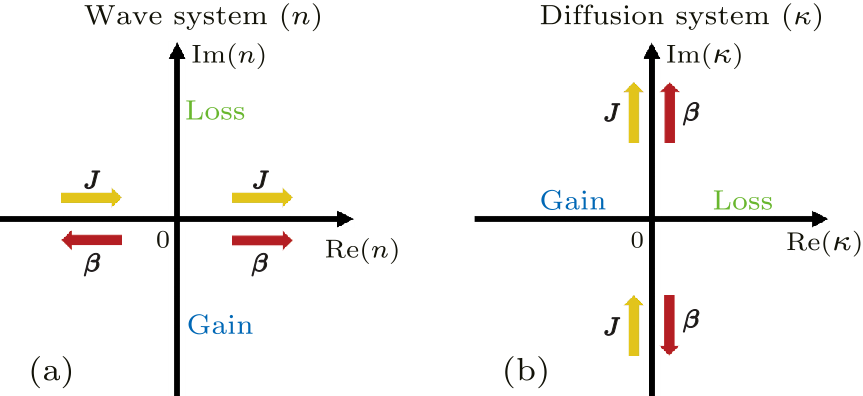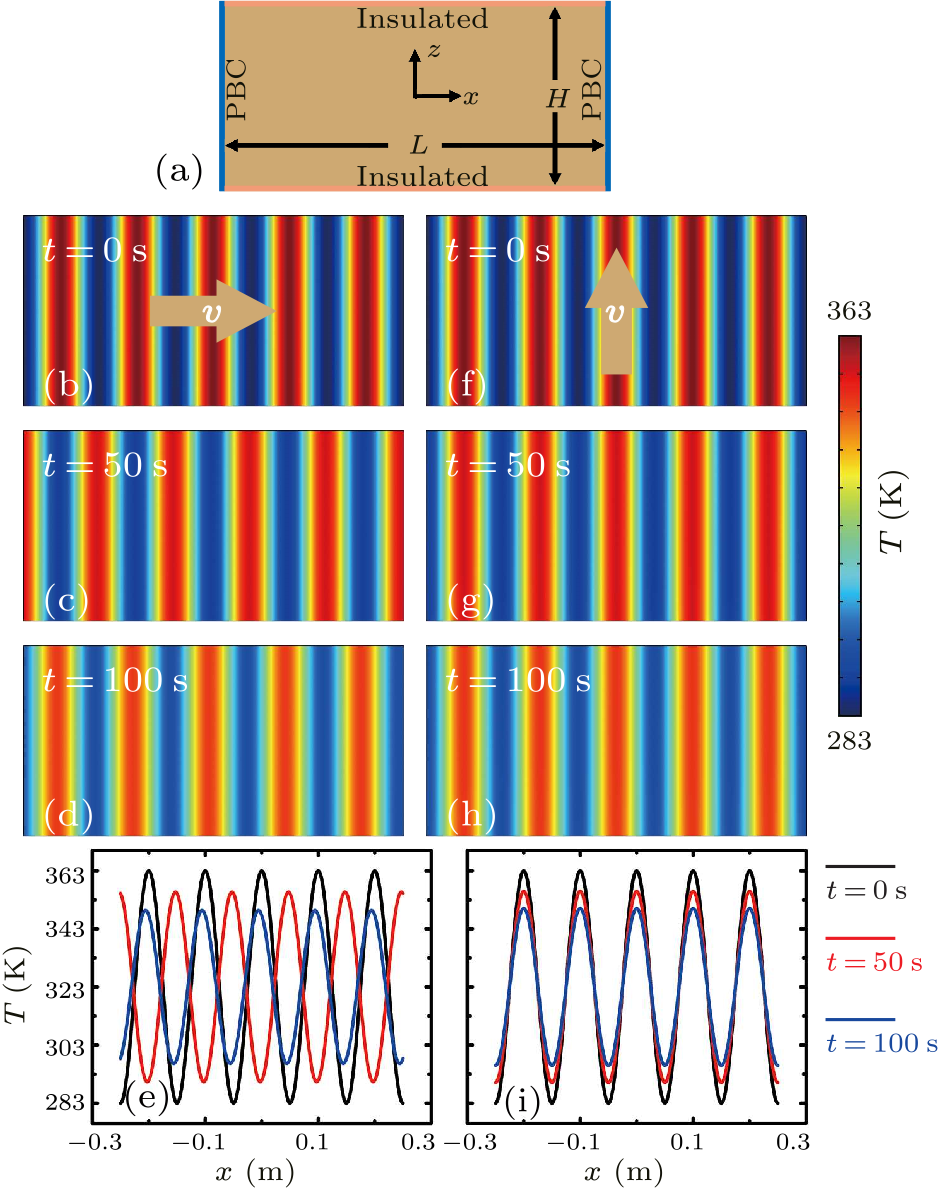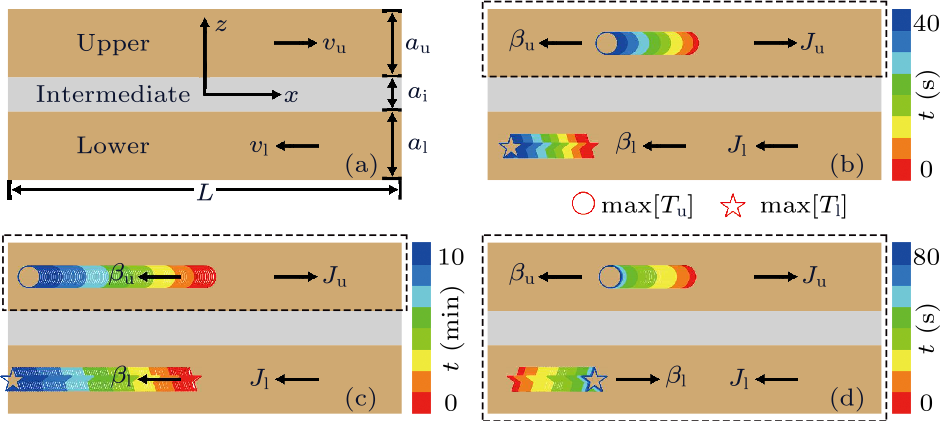
Fig. 1. Comparison between (a) wave system and (b) diffusion system. Here $n$ and $\kappa$ denote the complex refractive index and the complex thermal conductivity, respectively. ${\boldsymbol J}$ and ${\boldsymbol \beta}$ denote the energy flow and the wave vector, respectively.

Fig. 2. (a) Schematic diagram. Temperature evolutions with (b)–(e) ${\boldsymbol v}|| {\boldsymbol \beta}$ and (f)–(i) ${\boldsymbol v}\bot {\boldsymbol \beta}$. Parameters: $L=0.5$ m, $H=0.25$ m, $\rho C=10^{6}$ J$\cdot$m$^{-3}$K$^{-1}$, $\sigma =1$ W$\cdot$m$^{-1}$K$^{-1}$, and $v=1$ mm/s. PBC: periodic boundary condition.

Fig. 3. Two-dimensional negative thermal transport. (a) Schematic diagram with $a_{\rm u} =a_{\rm l} =2$ mm, $a_{\rm i} =1$ mm, $L=0.5$ m, $\sigma_{\rm u} =\sigma_{\rm l} =10$ W$\cdot$m$^{-1}$K$^{-1}$, $\sigma_{\rm i} =0.1$ W$\cdot$m$^{-1}$K$^{-1}$, and $\rho_{\rm u} C_{\rm u} =\rho_{\rm l} C_{\rm l} =\rho_{\rm i} C_{\rm i} =10^{6}$ J$\cdot$m$^{-3}$K$^{-1}$. These parameters lead to $g/\beta =4$ mm/s. (b) $v_{\rm u} =-v_{\rm l} =5$ mm/s. (c) $v_{\rm u} =0.5$ mm/s and $v_{\rm l} =-1.5$ mm/s. (d) $v_{\rm u} =-v_{\rm l} =1$ mm/s. Circles and stars denote the trajectories of max[$T_{\rm u}$] and max[$T_{\rm l}$], respectively.

Fig. 4. Experimental suggestions with a three-dimensional solid ring structure. (a) Schematic diagram with $r_{1} =80$ mm and $r_{2} =82$ mm. Other parameters are kept the same as those for Fig. 3(a). (b) $\varOmega_{\rm u} =-\varOmega_{\rm l} =0.063$ rad/s. (c) $\varOmega_{\rm u} =0.006$ rad/s and $\varOmega_{\rm l} =-0.019$ rad/s. (d) $\varOmega_{\rm u} =-\varOmega_{\rm l} =0.013$ rad/s.
| [1] | Veselago V G 1968 Sov. Phys. Usp. 10 509 | THE ELECTRODYNAMICS OF SUBSTANCES WITH SIMULTANEOUSLY NEGATIVE VALUES OF $\epsilon$ AND μ
| [2] | Pendry J B, Holden A J, Stewart W J and Youngs I 1996 Phys. Rev. Lett. 76 4773 | Extremely Low Frequency Plasmons in Metallic Mesostructures
| [3] | Pendry J B, Holden A J, Robbins D J and Stewart W J 1999 IEEE Trans. Microwave Theory Tech. 47 2075 | Magnetism from conductors and enhanced nonlinear phenomena
| [4] | Smith D R, Padilla W J, Vier D C, Nemat-Nasser S C and Schultz S 2000 Phys. Rev. Lett. 84 4184 | Composite Medium with Simultaneously Negative Permeability and Permittivity
| [5] | Smith D R and Kroll N 2000 Phys. Rev. Lett. 85 2933 | Negative Refractive Index in Left-Handed Materials
| [6] | Shelby R A, Smith D R and Schultz S 2001 Science 292 77 | Experimental Verification of a Negative Index of Refraction
| [7] | Pendry J B 2000 Phys. Rev. Lett. 85 3966 | Negative Refraction Makes a Perfect Lens
| [8] | Lagarkov A N and Kissel V N 2004 Phys. Rev. Lett. 92 077401 | Near-Perfect Imaging in a Focusing System Based on a Left-Handed-Material Plate
| [9] | Grbic A and Eleftheriades G V 2004 Phys. Rev. Lett. 92 117403 | Overcoming the Diffraction Limit with a Planar Left-Handed Transmission-Line Lens
| [10] | Seddon N and Bearpark T 2003 Science 302 1537 | Observation of the Inverse Doppler Effect
| [11] | Luo C Y, Ibanescu M H, Johnson S G and Joannopoulos J D 2003 Science 299 368 | Cerenkov Radiation in Photonic Crystals
| [12] | Ziolkowski R W 2003 Opt. Express 11 662 | Pulsed and CW Gaussian beam interactions with double negative metamaterial slabs
| [13] | Shendeleva M L 2002 Phys. Rev. B 65 134209 | Thermal wave reflection and refraction at a plane interface: Two-dimensional geometry
| [14] | Vemuri K P and Bandaru P R 2013 Appl. Phys. Lett. 103 133111 | Geometrical considerations in the control and manipulation of conductive heat flux in multilayered thermal metamaterials
| [15] | Vemuri K P and Bandaru P R 2014 Appl. Phys. Lett. 104 083901 | Anomalous refraction of heat flux in thermal metamaterials
| [16] | Yang T Z, Vemuri K P and Bandaru P R 2014 Appl. Phys. Lett. 105 083908 | Experimental evidence for the bending of heat flux in a thermal metamaterial
| [17] | Vemuri K P, Canbazoglu F M and Bandaru P R 2014 Appl. Phys. Lett. 105 193904 | Guiding conductive heat flux through thermal metamaterials
| [18] | Kapadia R S and Bandaru P R 2014 Appl. Phys. Lett. 105 233903 | Heat flux concentration through polymeric thermal lenses
| [19] | Hu R, Xie B, Hu J Y, Chen Q and Luo X B 2015 Europhys. Lett. 111 54003 | Carpet thermal cloak realization based on the refraction law of heat flux
| [20] | Li Y, Peng Y G, Han L, Miri M A, Li W, Xiao M, Zhu X F, Zhao J L, Alu A, Fan S H and Qiu C W 2019 Science 364 170 | Anti–parity-time symmetry in diffusive systems
| [21] | Cao P C, Li Y, Peng Y G, Qiu C W and Zhu X F 2020 ES Energy & Environ. 7 48 | High-Order Exceptional Points in Diffusive Systems: Robust APT Symmetry 2 Against Perturbation and Phase Oscillation at APT Symmetry Breaking
| [22] | Torrent D, Poncelet O and Batsale J C 2018 Phys. Rev. Lett. 120 125501 | Nonreciprocal Thermal Material by Spatiotemporal Modulation
| [23] | Guenneau S, Petiteau D, Zerrad M, Amra C and Puvirajesinghe T 2015 AIP Adv. 5 053404 | Transformed Fourier and Fick equations for the control of heat and mass diffusion
| [24] | Dai G L, Shang J and Huang J P 2018 Phys. Rev. E 97 022129 | Theory of transformation thermal convection for creeping flow in porous media: Cloaking, concentrating, and camouflage
| [25] | Yang F B, Xu L J and Huang J P 2019 ES Energy & Environ. 6 45 | Thermal Illusion of Porous Media with Convection-Diffusion Process: Transparency, Concentrating, and Cloaking
| [26] | Xu L J, Yang S, Dai G L and Huang J P 2020 ES Energy & Environ. 7 65 | Transformation Omnithermotics: Simultaneous Manipulation of Three Basic Modes of Heat Transfer
| [27] | Xu L J and Huang J P 2020 Sci. Chin.-Phys. Mech. Astron. 63 228711 | Chameleonlike metashells in microfluidics: A passive approach to adaptive responses
| [28] | Fan C Z, Gao Y and Huang J P 2008 Appl. Phys. Lett. 92 251907 | Shaped graded materials with an apparent negative thermal conductivity
| [29] | Chen T Y, Weng C N and Chen J S 2008 Appl. Phys. Lett. 93 114103 | Cloak for curvilinearly anisotropic media in conduction
| [30] | Xu L J, Dai G L and Huang J P 2020 Phys. Rev. Appl. 13 024063 | Transformation Multithermotics: Controlling Radiation and Conduction Simultaneously
| [31] | Xu L J and Huang J P 2020 Int. J. Heat Mass Transfer 159 120133 | Controlling thermal waves with transformation complex thermotics
| [32] | Hu R, Hu J Y, Wu R K, Xie B, Yu X J and Luo X B 2016 Chin. Phys. Lett. 33 044401 | Examination of the Thermal Cloaking Effectiveness with Layered Engineering Materials
| [33] | Hu R, Zhou S L, Li Y, Lei D Y, Luo X B and Qiu C W 2018 Adv. Mater. 30 1707237 | Illusion Thermotics
| [34] | Han T C, Yang P, Li Y, Lei D Y, Li B W, Hippalgaonkar K and Qiu C W 2018 Adv. Mater. 30 1804019 | Full-Parameter Omnidirectional Thermal Metadevices of Anisotropic Geometry
| [35] | Hu R, Huang S Y, Wang M, Luo X B, Shiomi J and Qiu C W 2019 Adv. Mater. 31 1807849 | Encrypted Thermal Printing with Regionalization Transformation
| [36] | Liu Y D, Song J L, Zhao W X, Ren X C, Cheng Q, Luo X B, Fang N X L and Hu R 2020 Nanophotonics 9 855 | Dynamic thermal camouflage via a liquid-crystal-based radiative metasurface
| [37] | Peng Y G, Li Y, Cao P C, Zhu X F and Qiu C W 2020 Adv. Funct. Mater. 30 2002061 | 3D Printed Meta‐Helmet for Wide‐Angle Thermal Camouflages
| [38] | Maldovan M 2013 Phys. Rev. Lett. 110 025902 | Narrow Low-Frequency Spectrum and Heat Management by Thermocrystals
| [39] | Xu L J, Yang S and Huang J P 2019 Phys. Rev. Appl. 11 034056 | Thermal Transparency Induced by Periodic Interparticle Interaction
| [40] | Cai Z, Huang Y Z and Vincent W 2020 Chin. Phys. Lett. 37 050503 | Imaginary Time Crystal of Thermal Quantum Matter
| [41] | Xu L J and Huang J P 2020 Appl. Phys. Lett. 117 011905 | Thermal convection-diffusion crystal for prohibition and modulation of wave-like temperature profiles